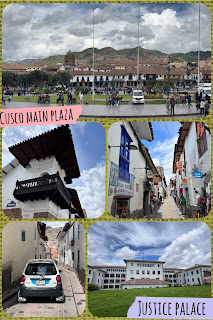On the 10hr (turned into an 11.5hr long bus journey) to Cusco, we stopped at 3 really interesting places.
The first stop was Pukara, which included a little museum that went into the history of the local people from 1600BC to more modern times. It explained how the hunter gatherer tribes start to settle and domesticate wild animals, how they built the system of terraces and how their culture has evolved over time. Lots of interesting old artefacts, including 2 mummified Inca remains.
The second stop was Raqchi, a very interesting archaeological site, containing 153 round houses (remains). Most of them were built pre-Inca times, with the Incas only adding a minority of them. It is thought that originally the houses were used as barracks, then later one as homes, workshops and storage places. What made it interesting is that the houses were arranges in rows, and all the buildings were connected. This was to help spread earthquake forces across all the buildings. Next to the houses, was a massive Inca temple. Sets of walls arrange so that the avenue would have the summer solstice shine down it, reminding us a little of Stonehenge. We also learnt that the Incas really like the trapezoid shape, with the wider base at the bottom. They used this a shape for windows and doorways.
The last stop was in a town called Andahuaylillas, to see the San Pedro Church. This is a very ornate Spanish Catholic Church, with lots of gold, painted frescoes and canvases. It is sometime called America’s Sistine Chapel, due to its very ostentatious decoration. Like most other Catholic Churches in Peru, it was built on top of the remains of an Inca temple, a great way for the Catholics to demonstrate their superiority.
Once in Cusco, we went on a fantastic walking tour of the city. We had a very knowledgeable guide that took us through the streets of the historic Cusco. The city itself was the central place for the Inca empire, and there are plenty of traces left in the city. The Spaniards tried very hard to destroy Inca culture, but building the cathedral and churches on the Inca temples, and repurposing the old palace to become the bishop’s palace. So one can still see the Inca craftsmanship, which Spanish built on top of.
One of the churches and convent, of Santo Domingo of Guzman, suffered a lot of damage during an earthquake in the 1950s. This exposed the original temple of Qurikancha, as the Spaniards found it easier to plaster over the walls rather than destroy it. One reason is that the walls were very solidly built, using huge stones. This temple was one of the main temples in Cusco and connected various elements of the Inca religion. It was interesting to see how carefully they designed it to match the sun during the solstice and the positioning of the other 2 temples around Cusco. The number 3 played an important role in their religion. There are 3 main animals: the puma, the condor and the serpent. There is the Sun, the Moon and the Stars. Along with 3 realms: The heavens (where the sun, moon and stars are), The surface, where people live and The under earth, with its Mother Earth and Father Earth deities. And just to make it more complex there is also a duality aspect, eg Man/Male and Woman/Female.
We ended the tour in the San Pedro market. Another fun market that was full of life and people. It was probably more busy with people as today there was an Easter related procession taking place in Cusco, and the population was out in force. They were celebrating the Earthquake version of Jesus. It came about when they took out a statue of Jesus on the crucifix out the cathedral during an earthquake, as soon as he was out, the earthquake stopped. Hence binding this statue to earthquakes. It’s fascinating to see how Peruvians have mixed Inca religion and Catholicism in their everyday life.
The second activity we did in Cusco was a chocolate workshop. It was a very hands on workshop where we picked coca beans, roasted them, de-shelled them and ground them into paste. We then learnt more about the history and intricacies of making chocolate followed by making our own chocolate treats (we skipped a few steps as we did not have the days required to do them). In between we also had “tea” made from the coca shell, which was surprising delicious. We also made and tired a coca drink made by the ancient Mayas and also the early Spaniards. It was a blast for the whole family!






















Comments
Post a Comment